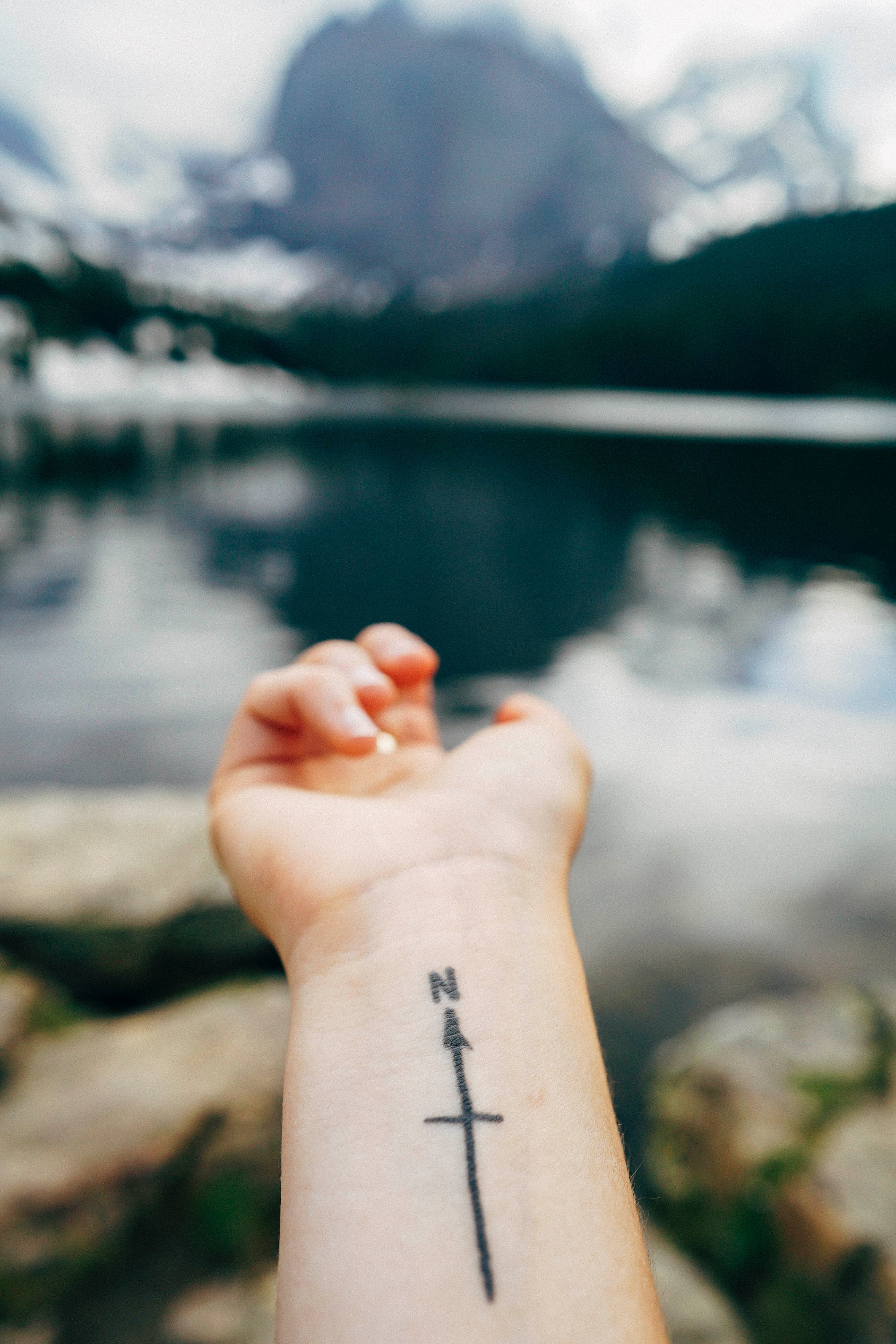Being alive blows me away. Every so often I’m gobsmacked anew by the miracle I am, and that you are. Animate, conscious meat sacks—bundles of aggregated Earth elements, able to sing and dance and tell stories. Able to learn. To remember.
Able to love. And to hate.
How crazy is this?!
This being alive thing is astounding! Awesome! Amazing! Wild!
I’m also able to know one day I’ll end. This self-aware, cohered dust that is me will return to the Earth from which I sprang. The miracle that is me will cease to exist in this form. This is, of course, true for every Earthling entity. I’m not special.
My friends in their 80s laugh at me—but I do fear aging and death. The other side of this amazing being alive thing is this amazing dying thing. I’ve already outlived both parents. I’ll be 80 myself in fifteen years.
I know how fast fifteen years goes. It’s not long.
Jed’s impending retirement has made this life of mine feel all the more urgent. For 50 years, I’ve been thinking someday I’ll get around to that. And next time I’ll do it different. Better. Somedays and next times are dwindling fast. I don’t have many do-overs left.
I want to live MY life, the life I’m meant to live. The life I choose for myself, not the one I’ve been trained to live. The life where I follow others’ rules and measure myself by others’ standards is a safe life. Safe, easy, and painful.
Now I see. This is what Lent is for: to examine my choices and conform them more fully to my values. So I won’t have regrets on my death bed. I want the Earthlings I love to know without an iota of doubt that I love them, through and through.
This revelation is nothing new, it turns out. Tradition and Mary Oliver have gotten here first.
Of course Lent is about mortality, says my husband when I share my revelation. He tells me Frederick Buechner said that Lent is for the big questions. Seven weeks to take meaning and mortality seriously.
And, of course also Mary Oliver, who asked What does it mean that Earth is so beautiful? And what shall I do about it? What is the gift that I should bring to the world? What is the life that I should live?
Living my life my way requires both going rogue and returning home. Following the direction of my heart will create more external conflict, as I bump up against established patterns and others’ preferences and expectations. Following my heart’s direction also means more internal peace, as the gap between my values and my choices narrows.
That gap hurts. That gap sucks energy. That gap is where I lose myself.
I want to close that gap. I want to recommit to myself and my priorities. Living in integrity with myself is self-ish. It’s also necessary, despite all the training to the contrary.
My integrity is my birthright.
Your integrity is your birthright.
Our integrity is our home.
PS. My newsletter is where I share my latest writing, news, and offerings. If you want to subscribe, you can do that here, and thank you!
[Photo: Natalie Rhea Rigg on Unsplash]
Tag Archives: death
Let God call you “Sweetcakes” for Christmas.
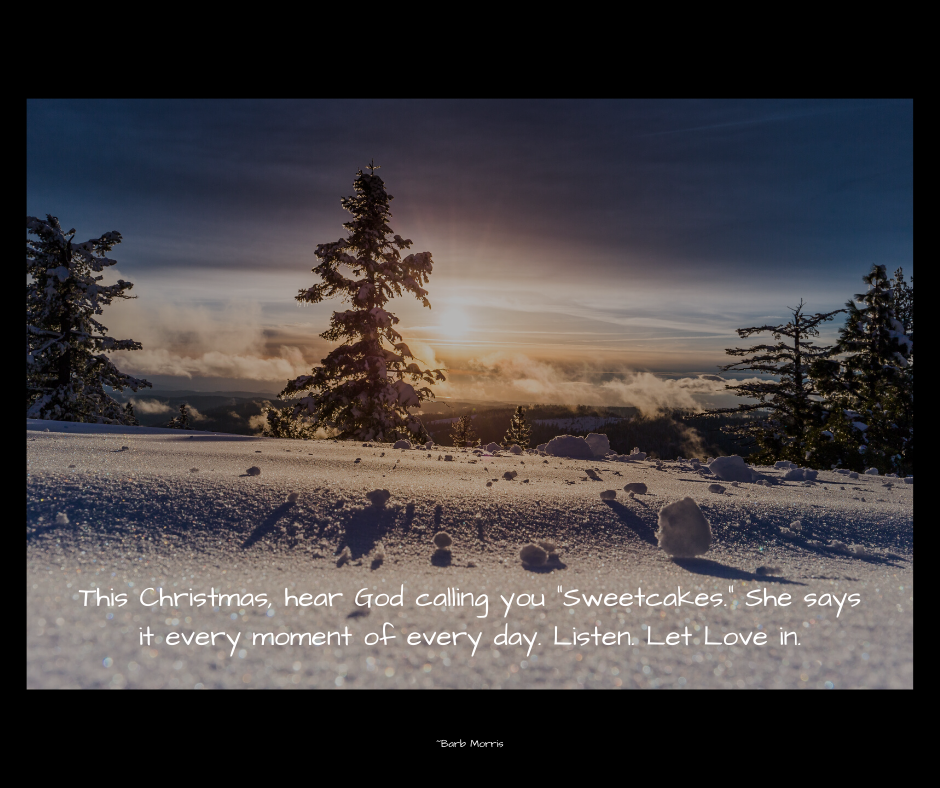
Forty years ago my dad died while skiing in Keystone, Colorado. That event put the cherry on top of the decade that undid me. I’d been mostly holding myself together through my parent’s divorce when I was 12, my big brother and eventually my little sister leaving to live with my dad, my dad’s subsequent three marriages, and my mom dating and marrying a man who violated me. Despite all that, I was still remarkably intact. Until December 15, 1979.
That sunny December morning shattered me. From that day on, the world felt lined by broken glass.
As children do, I made sense of my dad’s sudden death and all that had come before by concluding that I must be a bad person and I deserved this pain. So I renewed my efforts to be a good girl who followed the rules and did as she was told. Like many women living under patriarchy, I had a deep sense that I just wasn’t good enough, so I practiced other-focused, people-pleasing behavior and created a life that was too small.
I was desperate for ways to make life not hurt so damn much. Sharp surfaces, piercing nails, rattlesnakes with poisonous fangs – they seemed to be everywhere. So I stayed little and quiet and I stuck to well-trodden trails, striving to pad myself and blend in and make myself useful. A bad person pretending to be good.
I spent forty years seeking solace outside myself, searching for places that didn’t hurt. Trying to find answers to the wrong question. Looking outside myself, when what I needed to do was see the lie and let it go. I was trying to figure out how to live in a world of broken glass, since that seemed to be what I deserved, rather than allowing myself to see that I’d made the world of broken glass with my own mind.
I’ve realized that forty years is long enough to wander in the wilderness of suffering and self-loathing. The meaning I made from that terrible decade – that I’m not worthy of love and respect, that bad things only happen to bad people – is a lie. I know it’s a lie because I feel hard and separated from my soul when I believe it.
This lie of self-loathing can only be healed by choosing to believe the uncomfortable truth that God doesn’t make junk. Even squirrels have value and worth. All creation is holy and worthy and beloved, just because it exists. Value is intrinsic. It doesn’t have to be earned. We are born perfect.
The false belief my clients have in common, the core thought causing them distress, is this: “I’m not good enough. I have to try harder. I have to pretend to be perfect.”
Focusing on that false belief doesn’t heal it. Focusing on the false belief only cements it deeper. That belief is a habit. That’s all. We break old destructive habits by building new, better habits.
So shine a light on that false belief just long enough to identify it, and then set about gently dismantling the lie. Don’t take the wrecking ball to the lie, or do battle with it. Just focus, instead, on healing your brain by believing new, life-giving thoughts. “I am okay. I am enough. I am necessary. I am priceless.” Just five minutes a day will begin to weaken the old false beliefs and begin to build a home for the ages. The too-small dilapidated house you’ve been living in will slowly crumble and blow away.
Gently give your heart, who’s known all along that you are beloved and precious, light and rain and warmth.
The seed of your true self has been waiting for just such conditions to sprout.
She will burst her armored shell, break forth, and sing. Your small life will be broken open and will never be the same. The world changes when you become yourself.
I know now the World cried with us when my dad died on that mountain. Holiness was in the trenches with me as my world fell apart. Light was shining through the broken glass. Love has been holding my hand all along, leading me out of the wilderness back home to myself.
Christmas, the Feast of the Incarnation, is God saying “Yes” to us. The Divine is telling us this fleshy human life is beautiful.
This Christmas, hear Holiness say, “You matter. You are necessary. You belong. You are perfect.”
This Christmas, hear God calling you “Sweetcakes.” She says it every moment of every day. Listen. Let Love in.
God Says Yes To Me
I asked God if it was okay to be melodramatic
Kaylin Haught, From The Palm of Your Hand. © Tilbury House Publishers, 1995.
and she said yes
I asked her if it was okay to be short
and she said it sure is
I asked her if I could wear nail polish
or not wear nail polish
and she said honey
she calls me that sometimes
she said you can do just exactly
what you want to
Thanks God I said
And is it even okay if I don’t paragraph
my letters
Sweetcakes God said
who knows where she picked that up
what I’m telling you is
Yes Yes Yes
Photo by Denys Nevozhai on Unsplash
Your feelings are not your problem. Your feelings are your solution.
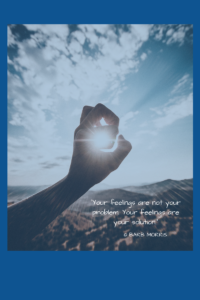 My mom was diagnosed with a rare and aggressive form of uterine cancer when she was 62. By the time it was found, the cancer had metastasized to her lungs, although we didn’t know that right away. The lung cancer would kill her a year later. My mom had been very healthy her whole life. Her plan to live to be 100 was one I heard often as a child. Her cancer was completely unexpected, which was why it was found too late to save her life. I was devastated. Everyone who knew her was devastated.
My mom was diagnosed with a rare and aggressive form of uterine cancer when she was 62. By the time it was found, the cancer had metastasized to her lungs, although we didn’t know that right away. The lung cancer would kill her a year later. My mom had been very healthy her whole life. Her plan to live to be 100 was one I heard often as a child. Her cancer was completely unexpected, which was why it was found too late to save her life. I was devastated. Everyone who knew her was devastated.
And she didn’t want to talk about dying.
We were living in Illinois, so I took both my kids, six and ten at the time, to Arizona with me for the summer. In June, the kids and I took a road trip with her to visit her favorite aunt in New Mexico. She went swimming with her grandkids. She took walks with her dog and her husband. She still didn’t want to talk about dying.
In July, my mom was slowing down. By August, I was doing all the cooking and cleaning for her and my stepfather. She had to sleep sitting up because she couldn’t breathe lying down. And she still didn’t want to talk about dying.
We went home to Illinois at the end of August. My mom’s last words to me were her promise that she’d call me when it was time for me to return and say good-bye.
She died September 1st, alone in her bed, never having asked me to come back.
I was heartbroken. I didn’t know I could hurt like that. I was also deeply angry. I was angry that she’d never let me tell her how much I loved her, and that she didn’t let any of us say goodbye. This was no accidental death, like my dad’s. My mom had plenty of advance warning. Hers could have been a much better death. It didn’t have to hurt so much. She could have died surrounded by people who loved her. She was a nurse. She knew how to do this right.
Grieving her death while I was so angry was harder and took a lot longer than it would have if she’d done it better.
I held onto this anger for years. I tried to let it go, but it stuck around. It persisted, despite therapy and many attempts to forgive.
I didn’t know at the time that I was carrying a lot of what the Acceptance and Commitment Therapy model calls “dirty pain.” Mixed in with the clean pain of my heart-rending grief was a ton of unnecessary suffering. (The Buddha and many healers since have put it this way: “Pain is inevitable. Suffering is optional.” In other words, pain comes and goes, as a result of injury or loss. Suffering hangs around, tied like a yoke to the thoughts we’re having about our pain.)
And then one day, almost twenty years after her death, I did something that helped my anger loosen its grasp. I filled out an Awareness Wheel about how much I still missed my mom, as a teaching example for a small group I was facilitating. (Download one here. The rest of this will make much more sense. And here’s a previous post about the Awareness Wheel.) I was encouraging this group of wise women to go deep in their choice of issue to work with. They encouraged me to be brave, too. What follows is verbatim from my Awareness Wheel that day.
In the middle, in the Issue circle, I wrote “I miss my mom.”
I Notice/Observed: “Tears, heaviness in chest, avoidance of talking about her, distracting myself, tightness in arms/neck/shoulders.”
I Think: “She shouldn’t have died so young. I wonder how she is. I hope she’s happy. I wish she’d had a better death. I wish I’d been able to say goodbye. She was selfish in her dying. I wish she was still alive. People should have talked about the family history of cancer.”
I Feel: “Sad, furious, love.”
I Want (for myself): “To feel at peace. To have you back. I Want (for you): That you’re happy. I Want (for us): That you know I love and forgive you.”
I Do (Past): “Stuff feelings. Be mad. Grieve.” I Do (Present): “Feel my grief. Acknowledge loss and your impact on my life.”
It’s useful simply to fill in a wheel when uncomfortable feelings arrive. It’s even more useful, after you do your wheel, to identify which thought is causing the most suffering. You do this by reading the thoughts you wrote and feeling how they feel in your body. Many of my thoughts were painful, but “She was selfish in her dying” felt like a knife to my gut.
I questioned that thought using Byron Katie’s method called The Work. (More on questioning our painful thoughts next time.) Simply put, through a series of questions, we get very clear on the results our thoughts are producing in our lives. Then, we turn the thought around and kindly investigate how the opposite might be true. This process wiggles the thought loose just a little and begins to grow new brain connections. Healing begins at the cellular level. We feel a little relief, at last.
When I gently investigated my thought “My mom was selfish in her dying,” I began to see how my mom had been generous in her dying. She let me take care of her. She spent time with her grandkids. She was trying to protect us.
When I let go of the thought that she’d been selfish, I can just love her and miss her. I can see that she was doing the best she could with an incredibly scary sad thing. I can see the ways I’d been selfish in her dying, by wanting her to do it my way.
This is how healing has happened, for me. I still miss my mom, of course, and letting go of my anger is ongoing. Now, though, my grief is mostly good, clean, healing grief. I can tell when it’s mixed up with dirty pain, because they feel different in my body.
Martha Beck has said, “If a thought causes suffering, it isn’t true.” That’s an audacious statement. It’s a core belief of my coaching work, because I’ve found it to be true.
When you pay attention to uncomfortable feelings using an Awareness Wheel, you find the thoughts causing suffering. When you question the thoughts that cause you to suffer, you begin to change your brain. When you begin to change your brain, you heal. And that’s how your feelings aren’t your problem, but your solution.
Interested in talking further about this? Contact me here to schedule a conversation. I’d love to explore with you!
On the Last Day of the World
Here’s a poem about the last day of the world.
W. S. Merwin, “Place”
On the last day of the world
I would want to plant a tree
what for
not for the fruit
the tree that bears the fruit
is not the one that was planted
I want the tree that stands
in the earth for the first time
with the sun already
going down
and the water
touching its roots
in the earth full of the dead
and the clouds passing
one by one
over its leaves
And here’s my poem in response:
“On the Last Day of the World”
On the last day of the world
I would want to swallow dirt
what for
not for the dirt
to thank this sweet earth
for the gift and miracle
to bow to my debt
to take this earth into my body
as earth will
at sunset
on the last day of the world
fold me into hers
and the stars appearing
one by one
singing
~Barb Morris, after W. S. Merwin’s “Place”
What would you do on the last day of the world? Feel free to respond in prose form!
photo credit: raphael nogueira on unsplash
Death and Resurrection for Humans
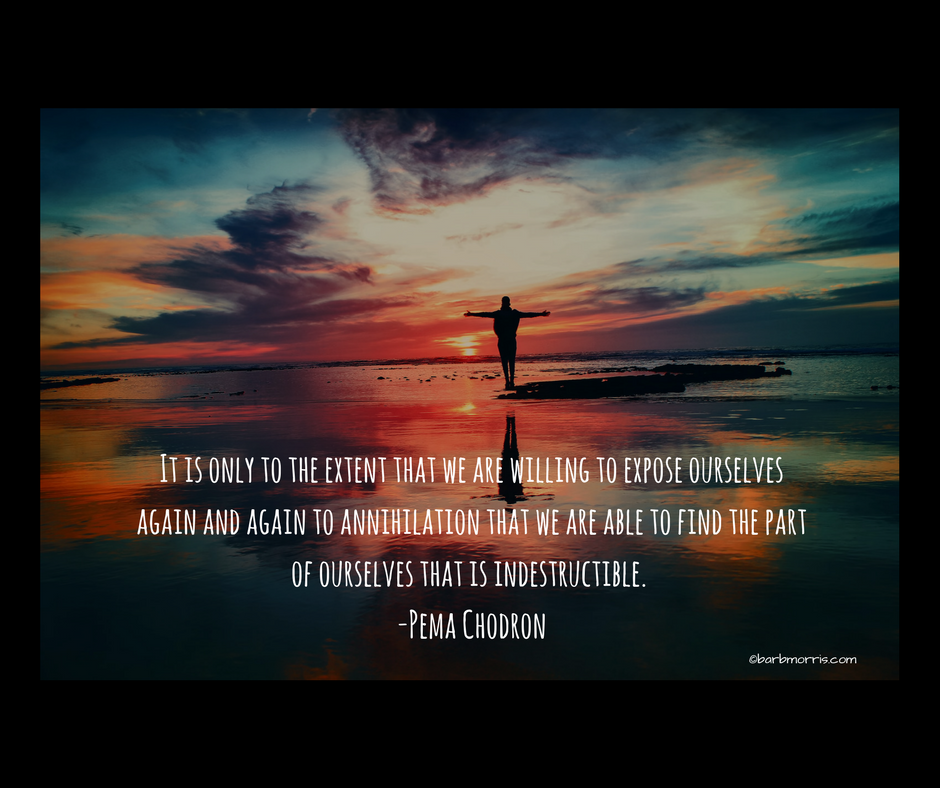 The Triduum, a fancy church word for the days between the Last Supper and Easter morning, the foundational Three Days of Christian faith, are here. Jesus faces the consequences of his radical fidelity to God’s radical compassion, and is put to death by the powers – the temple authorities and the Roman Empire. And then, Christians proclaim, he rises on Easter morning. We still feel his life empowering ours.
The Triduum, a fancy church word for the days between the Last Supper and Easter morning, the foundational Three Days of Christian faith, are here. Jesus faces the consequences of his radical fidelity to God’s radical compassion, and is put to death by the powers – the temple authorities and the Roman Empire. And then, Christians proclaim, he rises on Easter morning. We still feel his life empowering ours.
What difference does that make for me?
Here’s what I think: If I, following Jesus’ example, choose to let go of false identities, untrue selves, the things that I think are me but aren’t, Jesus’ resurrection is the promise that there will be something left of me.
And what will be left is the real me, the me that lives in God. The me that’s irrevocably connected to the Source of All – bright, shiny, holy, full of potential.
Many of you will recognize Pema Chodron as a Tibetan Buddhist teacher. I don’t believe that this death and resurrection cycle is exclusive to Christianity. It’s all around us and within us, and easy to see when Spring arrives. Death and resurrection is embedded in the world. Jesus is one way into this Mystery. He’s my way, and perhaps he’s not yours.
However you enter this mystery, may your Three Days be blessed with holy self-annihilation. And may you rise again – a realer, truer, more grounded version of who you actually are.
Seven Things I Wish I’d Known about Change Fifty Years Ago
 I’m 59 years old. Maybe I’m just a slow learner, and everyone else knows this stuff already. But, just in case, here are seven things I’ve recently learned about change that I wish I’d known fifty years ago
I’m 59 years old. Maybe I’m just a slow learner, and everyone else knows this stuff already. But, just in case, here are seven things I’ve recently learned about change that I wish I’d known fifty years ago
1. Change is normal.
Childhood is not an assembly line from which we emerge ready to roll at 21 years old. I know. This seems obvious, right? But this mechanistic model of human development pervades our culture. The idea that we should have our shit together and our ducks in a row by our early twenties is pervasive and harmful and everywhere. In this model, change feels like brokenness rather than aliveness. And women, because our bodies change more way than men’s, pay a steeper price.
Change is a big deal, and it can rock our world. We need to find ways to support and help ourselves through it, rather than beating ourselves up when we don’t navigate it smoothly.
We were not taught, most of us, how to do this.
Change is encoded into the DNA of the world. Even nonliving Earthly entities are constantly changing. Planets circle. Tides go in and out. Water cycles. Rocks become dirt.
2. Every change is loss.
Every change is a death and rebirth. Even the happy changes involve loss. “Every new beginning comes from some other beginning’s end,” sing Semisonic in “Closing Time.” In this season of graduations and weddings, let’s acknowledge that even changes we’ve longed for and dreamed of require the death of something. Maybe it’s not much of anything, but there’s always something we leave behind that we value.
3. Change does not equal transformation.
Change is inevitable, but transformation is optional. And it’s transformation that we need to undergo in order to move forward. We need to acknowledge, and grieve, the death and loss inherent in any change so we can make room for new life. Yes, again, even the happy changes. (See William Bridges’ Transitions for a lot more on this topic. What he calls “transition” I’m labeling “transformation.”)
We can opt out of transformation, though. We can just let our physical realities shift while refusing to acknowledge and deal with the grief inherent in change. This refusal will bite us in the butt, eventually. Refusing to consciously transform, even when a change is unwanted, will leave us with a burden of bitterness, regret, and stuckness that will eventually require attention.
4. Change has resonance.
We tend to do change the same way over and over, unless we bring our patterns to conscious awareness. This is fine if we’re ninja change masters and we handle transformation with grace and ease.
The first big change I remember is when my family fell apart. My dad’s drinking and my parents’ fighting; violence in the house; my dad moving out followed by divorce; my big brother going to live with my dad; losing our house in the woods, our horses, and our dog – all from 6th to 8th grade. I felt completely out of control, because I was. So I learned that I wasn’t in charge of my life. I learned to just close my eyes, keep my head down, and hang on, because there wasn’t a damn thing I could do about any of it.
Since then, I’ve left multiple homes and jobs I loved because my husband was pursuing his career. I did this willingly. I behaved as though I didn’t have a choice, and I didn’t thoroughly grieve those losses. I didn’t consciously refuse to transform, I just didn’t know any better.
5. Change has a predictable pattern.
A common metaphor for this pattern is a butterfly’s life cycle. It’s a really good metaphor.
First, the caterpillar has no choice. She simply runs out of steam and has to stop. Then she creates a chrysalis for herself, inside which she COMPLETELY MELTS DOWN. Next, she has to wait, be goo, and let the imaginal cells do their work of remaking her. This stage cannot be rushed, for butterflies or for people. Because we’re conscious beings, we’re aware of how uncomfortable and counter-cultural this waiting is. It’s an unknown territory, not-this-anymore-but-not-yet-that, and we often panic. Rushing is a mistake. This is where faith comes in. Finally, when it’s time and the work of the chrysalis is done, we are reborn.
This pattern of transformation is everywhere.
6. Change is cycles within cycles.
Change isn’t linear. See number one. We will almost certainly be in the dying phase of one cycle and be feeling reborn in another area of our lives. For example, I’m coming to terms with being almost sixty, entering the final decades of my life. I’m grieving the loss of my young body and the physical resilience I’ve taken for granted. At the same time, I’m experiencing a profound rebirth of purpose as I commit to my life coaching practice and to writing.
Cell turnover, cell death and rebirth, is going on at a furious clip within my aging body, just as the day cycles within the moon cycles within the cycles of the seasons, all within the context of Earth’s life and death, which is in turn embedded in a Universe with a beginning and an end.
If you believe there’s solid ground somewhere and all you have to do is find it, good luck with that.
7. We’re never done.
Simple as that. We’re never done changing, not until we die. Not even after we die, probably, because the atoms and molecules that made up US are entangled with each other even after our bodies decompose and return to Earth. They are reborn as something or someone else, which is always part of us in some mysterious way. So even after we die, we continue as part of the dance.
And isn’t that wonderful?
If you’d like to continue the conversation, please leave a comment below. If you’re interested in coaching, I offer a free one-hour consultation. Follow this link for details!
You Don’t Have to Earn Your Easter
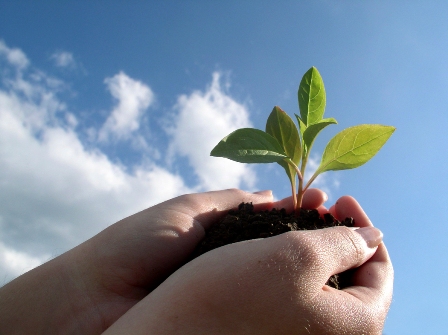 There’s a moment in the Easter Vigil that’s always struck me as wrong.
There’s a moment in the Easter Vigil that’s always struck me as wrong.
We’ve kindled the new fire of Easter. We’ve lit and processed the Paschal Candle. Someone’s sung the Exultet. We’ve sat for an hour in the darkened church, lit only by candlelight, listening to stories from the Hebrew tradition – Creation, the Garden, Noah and the Flood, the Exodus, and my personal favorite – the Valley of Dry Bones.
Then, out of nowhere it seems, the celebrant simply stands up and says “Alleluia! Christ is risen!” The people reply, “The Lord is risen, indeed! Alleluia!” and the organ starts playing and the bright artificial lights get flipped on and the altar guild carries out flowers and butterflies and suddenly, willy nilly, Lent is over and it’s Easter, even though outside it’s the dark of the night.
This moment has always seemed so wrong to me. It’s felt abrupt and fake and WAY too easy. Shouldn’t you have to work for resurrection?, I think. Shouldn’t you have to earn it somehow?
Then, this year, I got it.
No, you do NOT have to work for resurrection.
Yes, it IS just this easy.
All you have to do to get resurrection is show up and turn on the lights.
The hard part for most of us, I think, is letting it be Easter.
All we need to do to get resurrection, to let Love Life God Whatever flow, is go to our tombs, the places where we keep our dead things, allow ourselves mercy, then let go. Love will do the rest.
Resurrection is easy. It’s also scares me, just like it scared Jesus’s followers that first Easter morning.
I know the contours of my tomb and the heft of my dead things – my wounds and my stories and my suffering – all too well. They’re familiar to me. I know who I am when I’m wrapped in them.
Who will I be without my wounds and stories and suffering?
Who will I be if I’m not forever trying and working and efforting?
Who is Easter me?
Who will resurrected you be?
This is perhaps the work of faith – to show Love to the door of our deadness, allow her access, and watch her transform the dead things into Life.

